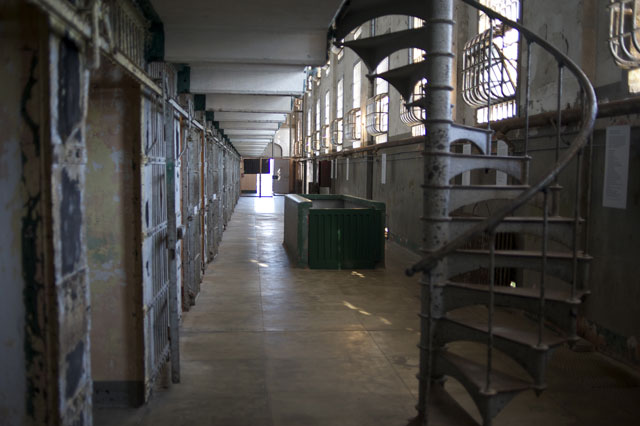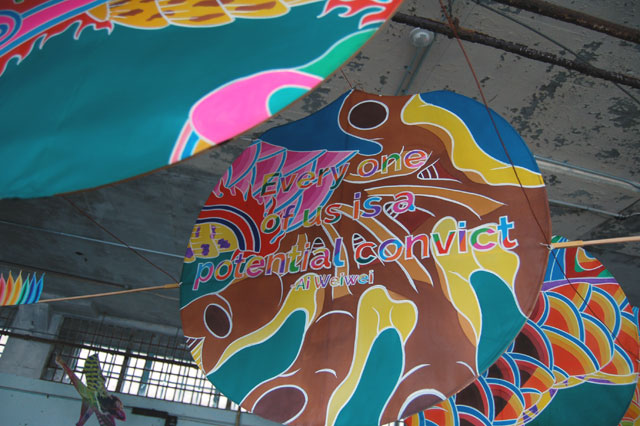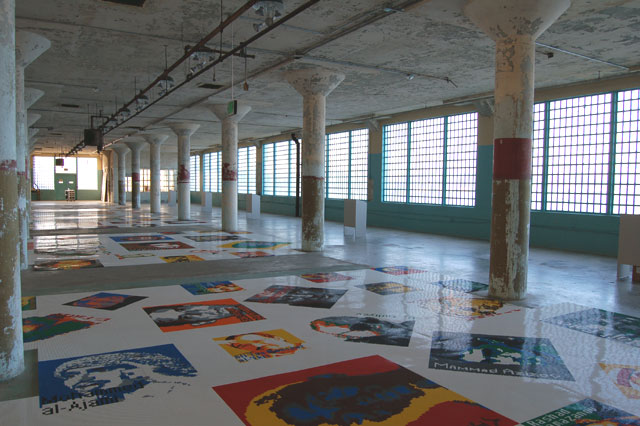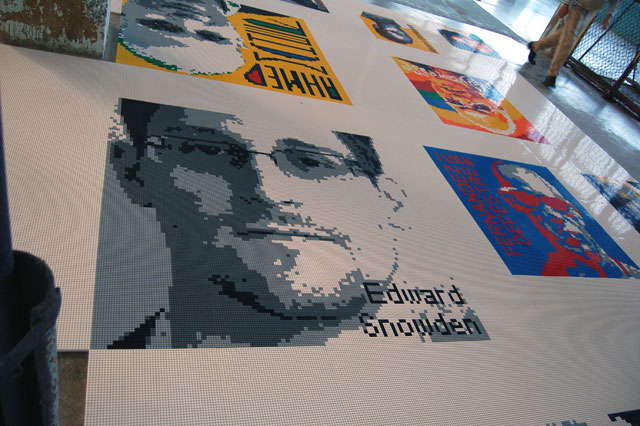The only way to get to the exhibit is to hop on a ferry. Once you reach the island in the middle of the San Francisco bay, follow signs that lead to a building marked “Penitentiary Laundry” and there you’ll be greeted by the head of a dragon kite. For-Site Foundation founder Cheryl Haines curated the exhibit.
“This in my mind is the pièce de résistance,” Haines says, as she takes in the dragon head just before it’s installed. “I just got goose bumps.”
The massive, yet delicate kite in a rainbow of hues snakes around columns of peeling, institutional green paint.
Haines dreamed up the idea of bringing Ai’s art to Alcatraz three years ago. The artist — perhaps best known for his work on the 2008 Beijing Olympic “Birds Nest” stadium — was released from an 81-day detention by Chinese authorities for alleged tax evasion. Ai’s supporters say it was more an attempt to clamp down on his criticism of China’s government. Haines says all the works touch on themes of incarceration and individual rights, including the kite.
“It’s suspended above the viewer. It will be flying; it will be free,” Haines says. “But it’s also restricted within the building, so there’s this really interesting conversation between control and freedom.”
“Restrictions and freedom are basically two sides of the same thing,” said Ai Weiwei from his Beijing studio last month. “The two faces of the matter.”
A massive, five-ton bird’s wing further reflects that point. Made from metal panels once used as solar cookers in Tibet, the wing appears trapped in a basement. It’s viewable only from above through broken glass windows. Haines says Ai is also giving a nod to the island’s role as a seabird sanctuary. “His ability to interpret space and engage audience is unparalleled.”
They are skills Ai Weiwei has come to rely on. Unable to leave China after authorities confiscated his passport, Ai had to envision Alcatraz from his Beijing studio, including a row of crumbling prison cells for another work: a sound installation that pipes in the voices of people imprisoned for expressing their views.

In one cell, music by the Russian feminist punk band Pussy Riot plays from decaying air vents. In 2012, the band’s members were sentenced to two years in prison after singing a song that protested Russian President Vladimir Putin.
Another cell plays the music of late musician Fela Kuti, who decried the Nigerian government and served 20 months in prison for alleged currency smuggling.
The U.S. is also implicated. A recording of a Hopi Indian chant plays in one of Alcatraz’s psychiatric observation cells. Nineteen members of the Hopi tribe were jailed at Alcatraz in 1895 for opposing the forced education of their children in government boarding schools.
This 3-and-a-half million dollar, mostly privately funded project, has been a major undertaking. National parks officials had to seek the clearance of the U.S. state department to host one of China’s most vocal critics on federal land. None of the site’s historic walls could be harmed.
“We cannot touch anything, add anything, it’s a hanging installation,” Ai Weiwei said. “Like prisoners themselves who are only there for a period of time.”
No doubt, the obstacles also bring more attention to the exhibit. Chad Coerver, Chief Content Officer at the San Francisco Museum of Modern Art, says Ai needs visibility in the West.
“The more recognized he is, even though he’s incarcerated at home, the safer he is from eventually being shut off completely or disappeared again, as he was in 2011,” Coerver says. “It’s a very dicey gamble that he’s playing, because we know the West’s attention doesn’t always guarantee political freedom in China.”
The fight to stay visible permeates the artwork called Trace. More than 175 portraits made from Legos of “prisoners of conscience” cover a building floor. Prominent figures like Nelson Mandela and NSA contactor Edward Snowden are among those fashioned out of colorful plastic bricks, but many are likely unknown to most Americans.
“One thing about Ai Weiwei, he’s really doing either research, or he wants to understand,” says celebrated Oakland painter Hung Liu.
Liu is close friends with Ai Weiwei and grew up during China’s Cultural Revolution under Mao Tse Tung. Like Ai, whose poet father was exiled by Mao’s government and forced to clean lavatories, China’s politics and culture permeate her work. But she is wary of political art becoming too didactic.
“When you have a strong political agenda, strong message, you have to be careful if you want to use art form,” Liu says. Liu plans to take a serious look at Ai’s Alcatraz work, and hopes others will get past his superstar status and do the same.
“Ai Weiwei’s super famous. Some people call him a god,” Liu says. “I think it’s a little too far. People tried to make Mao Tse Tung a god, so in a bigger sense, I just feel like it’s important for other people to be critical.”
@Large: Ai Weiwei on Alcatraz is on view through April 26, 2015. For more information visit for-site.org.
Additional reporting by Monica Lam and Adam Grossberg.



